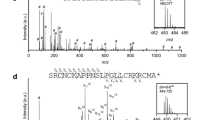Abstract
The venom glands of both workers and ergatoid queens of the ant Leptogenys diminuta contain 4–methyl-3–heptanol and a mixture of esters of this alcohol and long-chain fatty acids. Only the higher proportion of 4–methyl-3–heptanone in the queens represents a chemical difference between the castes. The Dufour gland secretion of workers and queens, however, shows considerable differences. Both share a series of long-chain hydrocarbons with 9and 7–pentacosene as the major substances of the secretion but are otherwise differentiated by the presence in the workers only of three farnesene isomers, whereas queens contain a wide range of substances. The mated queen had a very complex mixture of hydrocarbons, esters and terpenes. These substances were also present in the virgin females but in smaller quantities.
Similar content being viewed by others
REFERENCES
Ali, M. F., Attygalle, A. B., Morgan, E. D., and Billen, J. P. J. 1987. The Dufour gland substances of the workers of Formica fusca and Formica lemani (Hymenoptera: Formicidae). Comp. Biochem. Physiol. 88B:59–63.
Attygalle, A. B., and Morgan, E. D. 1984. Chemicals from the glands of ants. Chem. Soc. Rev. 13:245–278.
Attygalle, A. B., Vostrowsky, O., Bestmann, H. J., and Morgan, E. D. 1987. New chemicals from the Dufour gland of the formicine ant Lasius niger (Hymenoptera: Formicidae). Insect Biochem. 17:219–225.
Attygalle, A. B., Vostrowsky, O., Bestmann, H. J., Steghaus-Kovac, S., and Maschwitz, U. 1988. (3R,4S)-4–Methyl-3–heptanol, the trail pheromone of the ant Leptogenys diminuta. Naturwissenschaften 75:315–317.
Attygalle, A. B., Billen, J. P. J., Jackson, B. D., and Morgan, E. D. 1990. Morphology and chemical contents of Dufour glands of Pseudomyrmex ants (Hymenoptera: Formicidae). Z. Naturforsch. 45c:691–697.
BergstrÖm, G., and LÖfqvist, J. 1968. Odour similarities between the slave-keeping ants Formica sanguinea and Polyergus rufescens and their slaves Formica fusca and Formica rufibarbis. J. Insect Physiol. 14:995–1011.
BergstrÖm, G., and LÖfqvist, J. 1970. Chemical basis for odour communication in four species of Lasius ants. J. Insect Physiol. 16:2353–2375.
BergstrÖm, G., and LÖfqvist, J. 1973. Chemical congruence of the complex odoriferous secretions from Dufour's gland in three species of ants of the genus Formica. J. Insect Physiol. 19:877–907.
Billen, J. P. J. 1987. New structural aspects of the Dufour's and venom glands in social insects. Naturwissenschaften 74:340–341.
Billen, J., Evershed, R. P., Attygalle, A. B., Morgan, E. D., and ollett, D. G. 1986. The contents of the Dufour glands of workers of three species of Tetramorium (Hymenoptera: Formicidae). J. Chem. Ecol. 12:669–685.
Billen, J., Jackson, B. D., and Morgan, E. D. 1988. Secretion of the Dufour gland of the ant Nothomyrmecia macrops (Hymenoptera: Formicidae). Experientia 44:715–719.
Blum, M. S. 1981. Chemical defenses of arthropods. Academic Press, New York, pp. 206–238.
Bolton, B. 1975. A revision of the ponerine ant genus Leptogenys Roger (Hymenoptera, Formicidae) in the Ethiopian region. Bull. Br. Mus. (Nat. Hist.) Entomol. 31:235–305.
Heinze, J. 1998. Intercastes, intermorphs, and ergatoid queens: Who is who in ant reproduction? Insectes Soc. 45:113–124.
Ito, F. 1997. Colony composition and morphological caste differentiation between ergatoid queens and workers in the ponerine ant genus Leptogenys in the Oriental tropics. Ethol. Ecol. Evol. 9:335–343.
Ito, F. and Ohkawara, K. 2000. Production and behaviour of ergatoid queens in two species of the Indonesian ponerine ant genus Leptogenys (diminuta group) (Hymenoptera: Formicidae). Ann. Entomol. Soc. Am. 93:869–873.
Jackson, B. D., Cammaerts, M-C., Morgan, E. D., and Attygalle, A. B. 1990. Chemical and behavioral studies on the Dufour gland contents of Manica rubida (Hymenoptera: Formicidae). J. Chem. Ecol. 16:827–840.
Janssen, E., Übler, E., Bauriegel, L., Kern, F., Bestmann, H. J., Attygalle, A. B., Steghaus-Kova, S., and Maschwitz, U. 1997. Trail pheromone of the ponerine ant Leptogenys peuqueti (Hymenoptera: Formicidae): A multicomponent mixture of related compounds. Naturwissenschaften 84:122–125.
Maschwitz, U., and MÜhlenberg, M. 1975. Zur Jagdstrategie einiger orientalischer Leptogenys-Arten (Formicidae: Ponerinae). Oecologia 20:65–83.
Maschwitz, U., Steghaus-Kovac, S., Gaube, R., and HÄnel, H. 1989. A South East Asian ponerine ant of the genus Leptogenys (Hym., Form.) with army ant life habits. Behav. Ecol. Sociobiol. 24:305–316.
Mohammedi, A., Paris, A., Crauser, D., and Le Comte, Y. 1998. Effect of aliphatic esters on ovary development of queenless bees (Apis mellifera L.). Naturwissenschaften 85:455–458.
Morgan, E. D., and Thompson, L. D. 1985. Synthesis of (Z,E)-and (Z,Z)-α-farnesenes and homofarnesenes. J. Chem. Soc., Perkins Trans I 1985:339–404.
Morgan, E. D. 1990. Preparation of small scale samples from insects for chromatography. Anal. Chim. Acta 236:227–235.
Oldham, N. J., Morgan, E. D., Gobin, B., Schoeters, E., and Billen, J. 1994. Volatile secretions of the Old World army ant Aenictus rotundatus and the chemotaxonomic implications of army ant Dufour gland chemistry. J. Chem. Ecol. 20:3297–3305.
Oldham, N. J., Morgan, E. D., Agosti, D., and Wehner, R. 1999. Species recognition from postpharyngeal gland contents of ants of the Cataglyphis bicolor group. J. Chem. Ecol. 25:1383–1393.
Peeters, C. 1991. Ergatoid queens and intercastes in ants: Two distinct adult forms which look morphologically intermediate between workers and winged queens. Insectes Soc. 38:1–15.
Steghaus-Kovac, S., and Maschwitz, U. 1993. Predation on earwigs: A novel diet specialization within the genus Leptogenys (Formicidae: Ponerinae). Insectes Soc. 40:337–340.
Witte, V., and Maschwitz, U. 2000. Raiding and emigration dynamics in the ponerine army ant Leptogenys distinguenda (Hymenoptera, Formicidae). Insectes Soc. 47:76–83.
Author information
Authors and Affiliations
Rights and permissions
About this article
Cite this article
Maile, R., Jungnickel, H., Morgan, E.D. et al. Secretion of Venom and Dufour Glands in the Ant Leptogenys diminuta. J Chem Ecol 26, 2497–2506 (2000). https://doi.org/10.1023/A:1005528511208
Issue Date:
DOI: https://doi.org/10.1023/A:1005528511208




